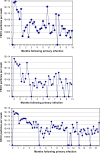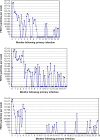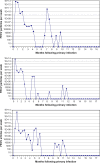Pathogenesis of feline enteric coronavirus infection
- PMID: 18538604
- PMCID: PMC7130060
- DOI: 10.1016/j.jfms.2008.02.006
Pathogenesis of feline enteric coronavirus infection
Abstract
Fifty-one specific pathogen-free (SPF) cats 10 weeks to 13 years of age were infected with a cat-to-cat fecal-oral passed strain of feline enteric coronavirus (FECV). Clinical signs ranged from unapparent to a mild and self-limiting diarrhea. Twenty-nine of these cats were FECV naïve before infection and followed sequentially for fecal virus shedding and antibody responses over a period of 8-48 months. Fecal shedding, as determined by real-time polymerase chain reaction (RT-PCR) from rectal swabs, appeared within a week and was significantly higher in kittens than older cats. FECV shedding remained at high levels for 2-10 months before eventually evolving into one of three excretion patterns. Eleven cats shed the virus persistently at varying levels over an observation period of 9-24 months. Eleven cats appeared to have periods of virus shedding interlaced with periods of non-shedding (intermittent or recurrent shedders), and seven cats ceased shedding after 5-19 months (average 12 months). There was no change in the patterns of virus shedding among cats that were excreting FECV at the time of a secondary challenge exposure. Four cats, which had ceased shedding, re-manifested a primary type infection when secondarily infected. Cats with higher feline coronavirus (FCoV) antibody titers were significantly more likely to shed virus, while cats with lower titers were significantly less likely to be shedding. Twenty-two kittens born to experimentally infected project queens began shedding virus spontaneously, but never before 9-10 weeks of age. Natural kittenhood infections appeared to be low grade and abortive. However, a characteristic primary type infection occurred following experimental infection with FECV at 12-15 weeks of age. Pregnancy, parturition and lactation had no influence on fecal shedding by queens. Methylprednisolone acetate treatment did not induce non-shedders to shed and shedders to increase shedding.
Figures











References
-
- Addie D.D., Schaap I.A., Nicolson L., Jarrett O. Persistence and transmission of natural type I feline coronavirus infection, Journal of General Virology 84 (10), 2003, 2735–2744. - PubMed
-
- Addie D.D., Paltrinieri S., Pedersen N.C. Second international feline coronavirus/feline infectious peritonitis symposium. Recommendations from workshops of the second international feline coronavirus/feline infectious peritonitis symposium, Journal of Feline Medicine and Surgery 6 (2), 2004, 125–130. - PMC - PubMed
-
- Brandtzaeg P. Induction of secretory immunity and memory at mucosal surfaces, Vaccine 25 (30), 2007, 5467–5484. - PubMed
-
- Benetka V., Kolodziejek J., Walk K., Rennhofer M., Möstl K. M gene analysis of atypical strains of feline and canine coronavirus circulating in an Austrian animal shelter, Veterinary Record 159 (6), 2006, 170–174. - PubMed
Publication types
MeSH terms
Substances
Grants and funding
LinkOut - more resources
Full Text Sources
Medical
Miscellaneous

